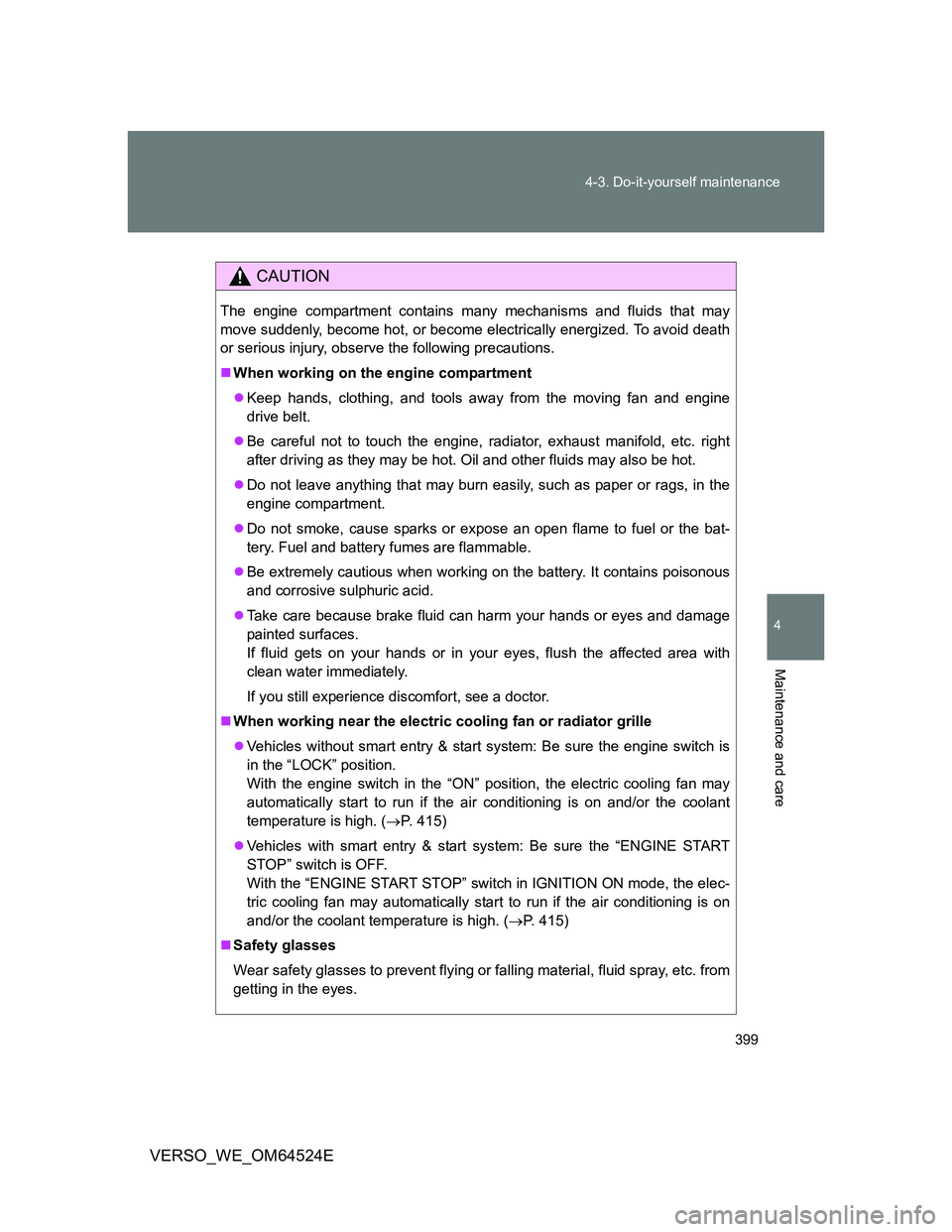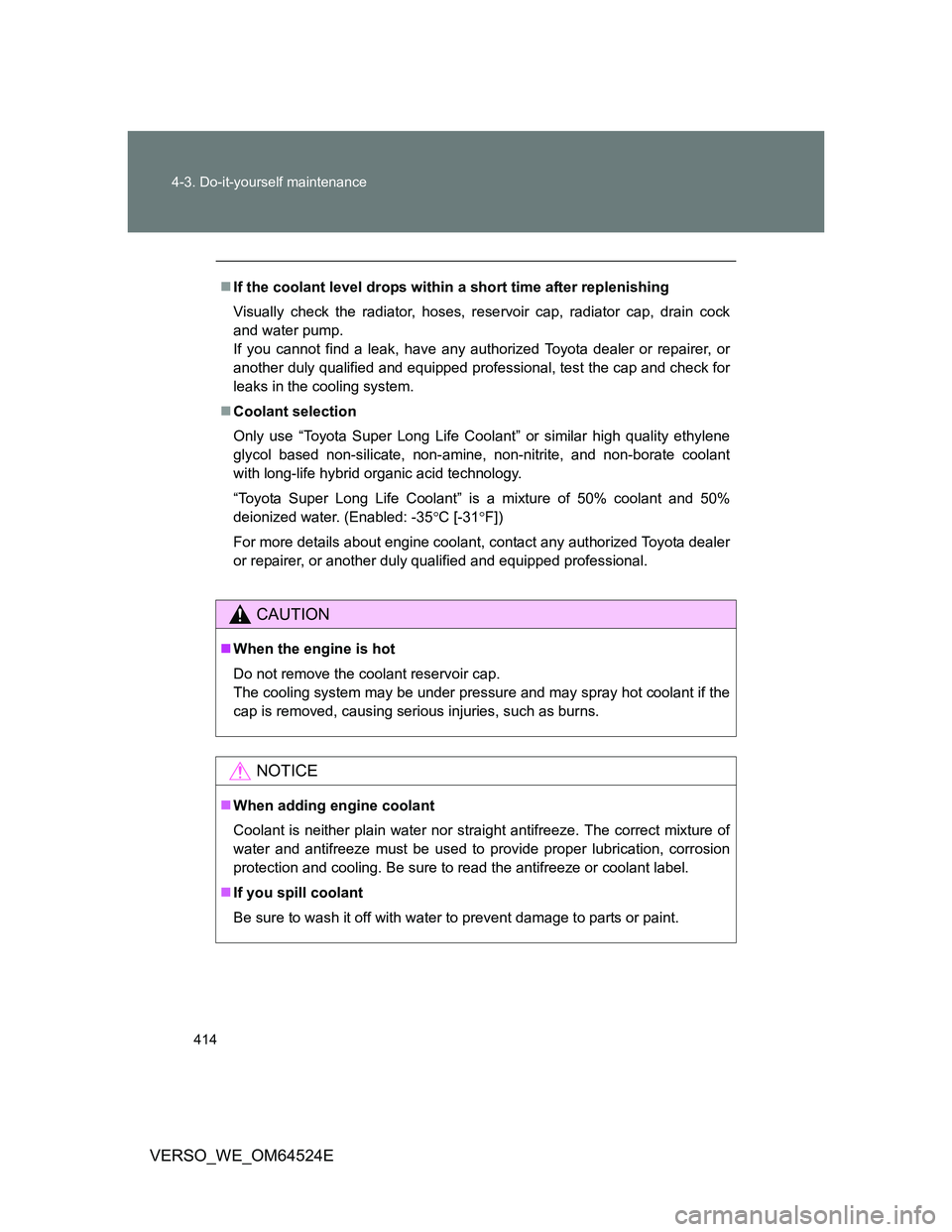Page 399 of 588

399 4-3. Do-it-yourself maintenance
4
Maintenance and care
VERSO_WE_OM64524E
CAUTION
The engine compartment contains many mechanisms and fluids that may
move suddenly, become hot, or become electrically energized. To avoid death
or serious injury, observe the following precautions.
When working on the engine compartment
Keep hands, clothing, and tools away from the moving fan and engine
drive belt.
Be careful not to touch the engine, radiator, exhaust manifold, etc. right
after driving as they may be hot. Oil and other fluids may also be hot.
Do not leave anything that may burn easily, such as paper or rags, in the
engine compartment.
Do not smoke, cause sparks or expose an open flame to fuel or the bat-
tery. Fuel and battery fumes are flammable.
Be extremely cautious when working on the battery. It contains poisonous
and corrosive sulphuric acid.
Take care because brake fluid can harm your hands or eyes and damage
painted surfaces.
If fluid gets on your hands or in your eyes, flush the affected area with
clean water immediately.
If you still experience discomfort, see a doctor.
When working near the electric cooling fan or radiator grille
Vehicles without smart entry & start system: Be sure the engine switch is
in the “LOCK” position.
With the engine switch in the “ON” position, the electric cooling fan may
automatically start to run if the air conditioning is on and/or the coolant
temperature is high. (P. 415)
Vehicles with smart entry & start system: Be sure the “ENGINE START
STOP” switch is OFF.
With the “ENGINE START STOP” switch in IGNITION ON mode, the elec-
tric cooling fan may automatically start to run if the air conditioning is on
and/or the coolant temperature is high. (P. 415)
Safety glasses
Wear safety glasses to prevent flying or falling material, fluid spray, etc. from
getting in the eyes.
Page 405 of 588
405
4-3. Do-it-yourself maintenance
4
Maintenance and care
VERSO_WE_OM64524E
Engine compartment
Gasoline engine
Washer fluid tank (P. 418)
Engine coolant reservoir
(P. 413)
Engine oil level dipstick
(P. 408)
Engine oil filler cap
(P. 410)Fuse box (P. 436)
Battery (P. 415)
Electric cooling fan
Condenser (P. 415)
Radiator (P. 415)
Page 406 of 588
406 4-3. Do-it-yourself maintenance
VERSO_WE_OM64524E
Diesel engine
Washer fluid tank (P. 418)
Engine coolant reservoir
(P. 413)
Engine oil level dipstick
(P. 408)
Engine oil filler cap
(P. 410)Fuel filter (P. 419)
Fuse box (P. 436)
Battery (P. 415)
Condenser (P. 415)
Electric cooling fans
Intercooler (P. 415)
Radiator (P. 415)
Page 414 of 588

414 4-3. Do-it-yourself maintenance
VERSO_WE_OM64524E
If the coolant level drops within a short time after replenishing
Visually check the radiator, hoses, reservoir cap, radiator cap, drain cock
and water pump.
If you cannot find a leak, have any authorized Toyota dealer or repairer, or
another duly qualified and equipped professional, test the cap and check for
leaks in the cooling system.
Coolant selection
Only use “Toyota Super Long Life Coolant” or similar high quality ethylene
glycol based non-silicate, non-amine, non-nitrite, and non-borate coolant
with long-life hybrid organic acid technology.
“Toyota Super Long Life Coolant” is a mixture of 50% coolant and 50%
deionized water. (Enabled: -35C [-31F])
For more details about engine coolant, contact any authorized Toyota dealer
or repairer, or another duly qualified and equipped professional.
CAUTION
When the engine is hot
Do not remove the coolant reservoir cap.
The cooling system may be under pressure and may spray hot coolant if the
cap is removed, causing serious injuries, such as burns.
NOTICE
When adding engine coolant
Coolant is neither plain water nor straight antifreeze. The correct mixture of
water and antifreeze must be used to provide proper lubrication, corrosion
protection and cooling. Be sure to read the antifreeze or coolant label.
If you spill coolant
Be sure to wash it off with water to prevent damage to parts or paint.
Page 441 of 588
441 4-3. Do-it-yourself maintenance
4
Maintenance and care
VERSO_WE_OM64524E
Fuse layout and amperage ratings
Engine compartment
FuseAmpereCircuit
1H-LP CLN30 A Headlight cleaner
2RDI FAN40 A Electric cooling fan(s)
3CDS FAN30 A Electric cooling fan(s)*1
4 ABS NO.1 50 A Anti-lock brake system, VSC+
5 HTR 50 A Air conditioning system
6ALT120 A
*2
Charging system, RDI FAN, CDS
FAN, H-LP CLN, FUEL OPN, ABS
NO.1, ABS NO.2, FR DEICER,
HTR, STV HTR, PWR OUTLET,
HTR SUB NO.1, HTR SUB NO.2,
HTR SUB NO.3, ECU-IG NO.2,
HTR-IG, WIPER, RR WIPER,
WASHER, ECU-IG NO.1, ECU-IG
NO.3, SEAT HTR, AM1, DOOR,
STOP, FR DOOR, POWER, RR
DOOR, RL DOOR, OBD, ACC-B,
RR FOG, FR FOG, DEF, TAIL,
PA N E L 140 A
*1
Page 446 of 588

446 4-3. Do-it-yourself maintenance
VERSO_WE_OM64524E
8ACC 7.5 AShift lock system, audio system,
main body ECU, power outlet
9 MIR HTR 10 A Outside rear view mirror defoggers
10 RR FOG 7.5 A Rear fog light
11 I G N 7 . 5 ASteering lock system, SRS airbag
system, multiport fuel injection sys-
tem/sequential multiport fuel injec-
tion system, automatic
transmission
*1, starting system
12 METER 7.5 A Gauges and meters
13 SEAT HTR
*2 15 A Seat heaters
14 HTR-IG 10 A Air conditioning system
15 WIPER 25 AWindshield wipers, rain-sensing
windshield wipers
16 RR WIPER 15 A Rear window wiper
17 WASHER 15 AWindshield washers, rear window
washer
18 ECU-IG NO.1 10 AMain body ECU, electric cooling
fan(s), shift lock system, anti-lock
brake system, steering sensor,
VSC+, headlight cleaner,
SEQUENTIAL switch, automatic
headlight leveling system, Electric
Power Steering
19 ECU-IG NO.2 10 ABack-up lights, charging system,
emergency flashers, rear window
defogger, front passenger’s seat
belt reminder light, “PASSENGER
AIRBAG” indicator, air conditioning
system, Toyota parking assist-sen-
sor indicator, Toyota parking assist-
sensor switch
20 OBD 7.5 A On-board diagnosis system
FuseAmpereCircuit
Page 531 of 588
5
531 5-2. Steps to take in an emergency
When trouble arises
VERSO_WE_OM64524E
NOTICE
To prevent damaging the vehicle (vehicles with a manual transmission)
Do not pull- or push-start the vehicle, because the catalytic converter may
overheat and become a fire hazard.
When handling jumper cables
Be careful that the jumper cables do not become tangled in the cooling fan
or any of the belts when connecting or disconnecting them.
Page 532 of 588
532
5-2. Steps to take in an emergency
VERSO_WE_OM64524E
If your vehicle overheats
If your engine overheats:
Stop the vehicle in a safe place and turn off the air condi-
tioning system.
Check to see if steam is coming out from under the hood.
If you see steam:
Stop the engine. Carefully lift the hood after the steam
subsides and then restart the engine.
If you do not see steam:
Leave the engine running and carefully lift the hood.
Check to see if the cooling fan is operating.
If the fan is operating:
Wait until the high engine coolant temperature warning
light (Red) goes off and then stop the engine.
If the fan is not operating:
Stop the engine and call any authorized Toyota dealer or
repairer, or another duly qualified and equipped profes-
sional.